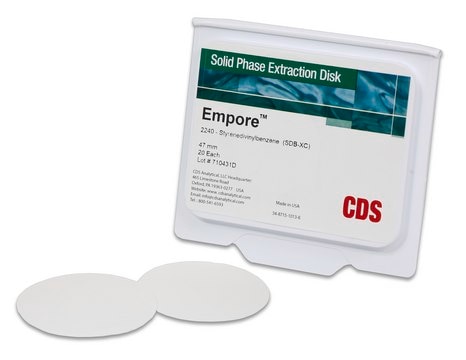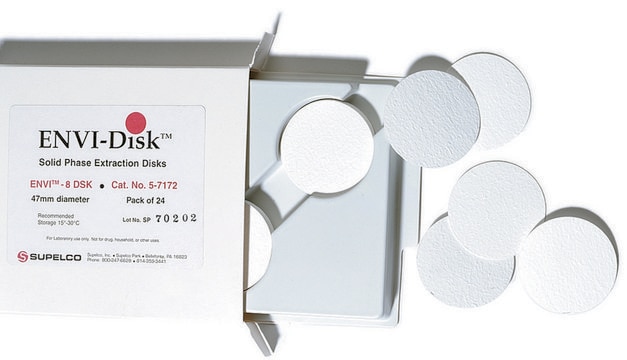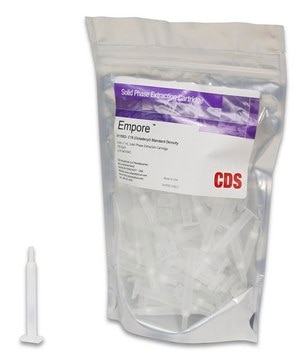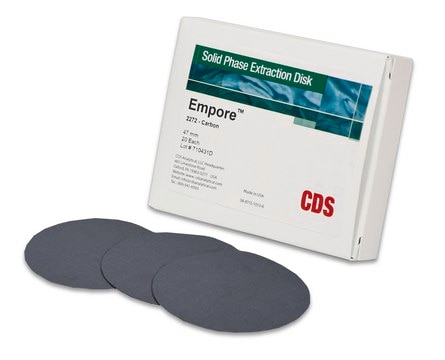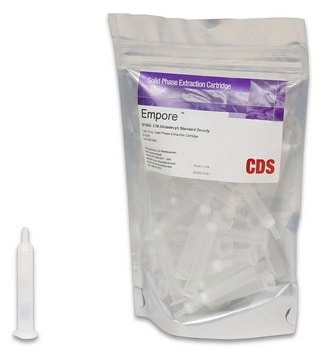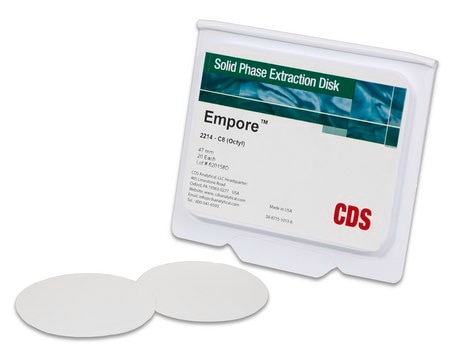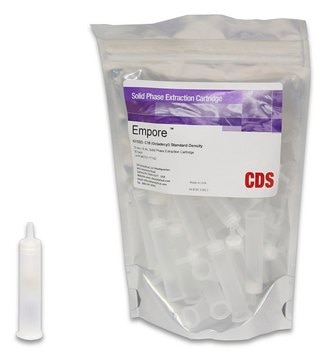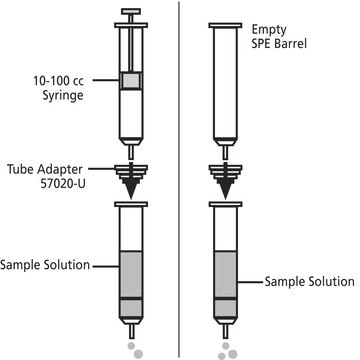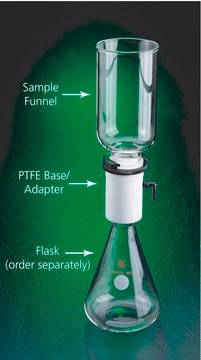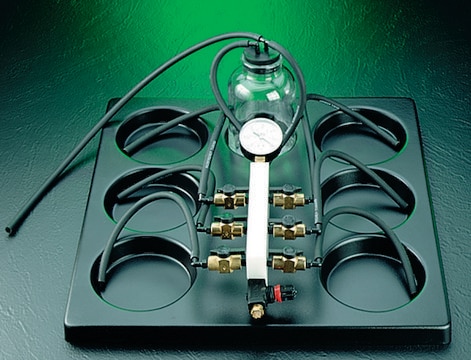66883-U
Empore™ SPE Disks
C18, diam. 47 mm, pk of 20
Synonym(s):
C18, SPE disk, 47 mm
Sign Into View Organizational & Contract Pricing
All Photos(1)
About This Item
UNSPSC Code:
13111000
NACRES:
NB.21
Recommended Products
product name
Empore™ SPE Disks, matrix active group C18, diam. 47 mm, pk of 20
description
C18
Quality Level
product line
Empore™
packaging
pk of 20
manufacturer/tradename
CDS Analytical 98-0604-0217-3
technique(s)
solid phase extraction (SPE): suitable
diam.
47 mm
membrane thickness
0.5 mm
matrix active group
C18
particle size
12 μm
Looking for similar products? Visit Product Comparison Guide
Related Categories
General description
Empore membrane SPE technology comprises of SPE particles tightly enmeshed within a network of inert PTFE fibrils (90% SPE particles : 10% PTFE, by weight). The SPE-membrane fabrication process results in a highly dense and uniform extraction medium that offers distinct advantages over traditional sorbent/packed-bed SPE products. Empore SPE technology provides a denser, more uniform extraction bed than traditional packed bed products allowing for smaller bed weights, shorter analyte to pore diffusion paths, and more efficient extractions.
The Empore line of SPE disks comprises of the most complete line of SPE disks for extracting large volumes of aqueous samples. The product line ranges from time-tested C18 to unique phase chemistries such as carbon and the highly polar Oil & Grease disk. The disks are ideal for environmental analysis where 1 L sample volumes are not uncommon and provide an efficient alternative to LLE.
Save Time & Money:
The Empore line of SPE disks comprises of the most complete line of SPE disks for extracting large volumes of aqueous samples. The product line ranges from time-tested C18 to unique phase chemistries such as carbon and the highly polar Oil & Grease disk. The disks are ideal for environmental analysis where 1 L sample volumes are not uncommon and provide an efficient alternative to LLE.
Save Time & Money:
- Reduced SPE Bed Mass = Reduced SPE Solvent & Elution Volumes
- Minimize SPE eluate evaporation time
- Potentially allows for direct injection of the SPE eluate
- Dense & Uniform Extraction Medium = No SPE Channeling and Voiding
- Efficient mass-transfer kinetics allow for faster flow rates
- Eliminate SPE fines improving column and instrument life
Application
Ideal for the extraction of semi- and non-volatile compounds from water and soil. Applicable for use with:
- EPA Method 506 - Phthlate & Adipate Esters
- EPA Method 508.1 - Chlorinated Pesticides, Herbicides and Organohalides
- EPA Method 525.2 - Semi-Volatile Organic Compounds
- EPA Method 532 - Phenylurea Pesticides
- EPA Method 550.1 - PAHs
- EPA Method 553 - Benzidines and Nitrogen-Containing Pesticides
- EPA Method 554 - Carbonyl Compounds
- EPA Method 555 - Chlorinated Acids
- 608ATP3M0222 - Organochlorine Pesticides and PCBs
- 1613B - Dioxins and Furans
- 3535 - Organichlorine Pesticides & Phthalate Esters
- 8330A - Nitroaromatics & Nitroamines
- 8095 - Explosives
- 8323 - Organotins
- 8321b - Solvent extractable non-volatile compounds
- Dioxin DLM01.1 - Octo-chlorinated Dibenzo-p-dioxins (CDDs) and Dibenzofurans (CDFs)
Legal Information
Empore is a trademark of CDS Analytical
Disclaimer
CDS Analytical LLC recently acquired the rights to Empore products from 3M Purification Inc. For an interim phase, you may receive products packaged with either manfacturer′s branding.
wgk_germany
WGK 3
flash_point_f
Not applicable
flash_point_c
Not applicable
Certificates of Analysis (COA)
Search for Certificates of Analysis (COA) by entering the products Lot/Batch Number. Lot and Batch Numbers can be found on a product’s label following the words ‘Lot’ or ‘Batch’.
Already Own This Product?
Find documentation for the products that you have recently purchased in the Document Library.
Customers Also Viewed
Fabrizia Brisdelli et al.
International journal of molecular sciences, 21(1) (2019-12-22)
Among natural products under investigation for their additive potential in cancer prevention and treatment, the flavonoid quercetin has received attention for its effects on the cell cycle arrest and apoptosis. In the past, we addressed this issue in K562 cells
Kaixin Wu et al.
Cell reports, 30(1), 25-36 (2020-01-09)
Known as a histone H3K9 methyltransferase, SETDB1 is essential for embryonic development and pluripotent inner cell mass (ICM) establishment. However, its function in pluripotency regulation remains elusive. In this study, we find that under the "ground state" of pluripotency with
Anja Fux et al.
Cell chemical biology, 26(1), 48-59 (2018-11-13)
Detection of dynamic protein-protein interactions within complexes and networks remains a challenging task. Here, we show by the example of the proteolytic ClpXP complex the utility of combined chemical cross-linking and mass spectrometry (XL-MS) to map interactions within ClpP and
Heeseon An et al.
Molecular cell, 74(5), 891-908 (2019-04-23)
Cells respond to nutrient stress by trafficking cytosolic contents to lysosomes for degradation via macroautophagy. The endoplasmic reticulum (ER) serves as an initiation site for autophagosomes and is also remodeled in response to nutrient stress through ER-phagy, a form of
Alban Ordureau et al.
Molecular cell, 70(2), 211-227 (2018-04-17)
Flux through kinase and ubiquitin-driven signaling systems depends on the modification kinetics, stoichiometry, primary site specificity, and target abundance within the pathway, yet we rarely understand these parameters and their spatial organization within cells. Here we develop temporal digital snapshots
Our team of scientists has experience in all areas of research including Life Science, Material Science, Chemical Synthesis, Chromatography, Analytical and many others.
Contact Technical Service